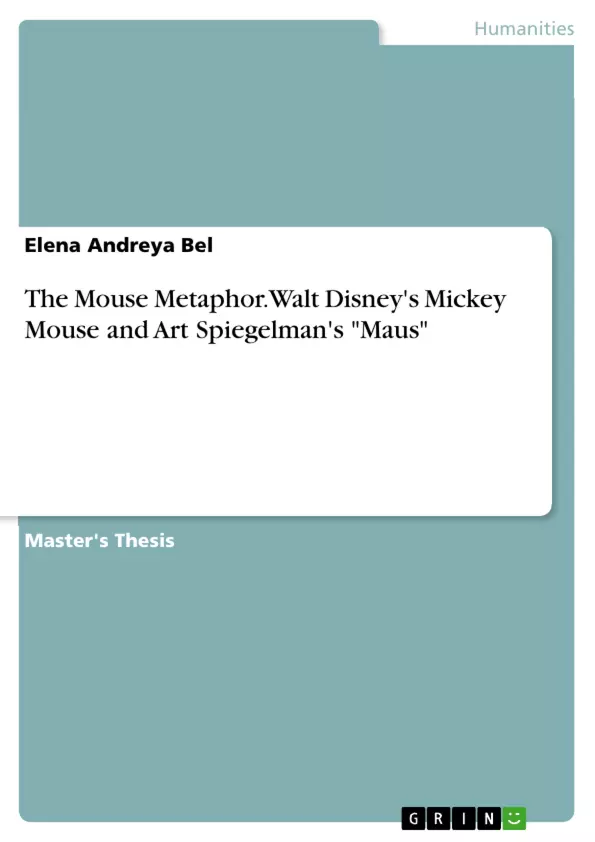This thesis contributes to a comprehensive exploration of the anthropomorphic mouse image in Art Spiegelman's graphic novel "Maus" as a reaction to Walt Disney's iconic Mickey Mouse. The discussion delves into the potential motivations and ideologies behind both characters, including Disney's hidden anti-Semitic tendencies. The thesis aims to scrutinize the intentions of these cartoonists and the historical context in which their creations emerged.
It employs a comparative approach, examining early sketches and illustrations, and utilizes primary sources, such as "Maus" and MetaMaus, as well as audio materials like interviews with Art Spiegelman. The structure of the thesis comprises chapters dedicated to the cultural significance of the mouse metaphor, Walt Disney's biography, the history of comics, Art Spiegelman's background and intentions, and concludes with a synthesis of research findings and hypothesis evaluation. This study seeks to shed light on the complex relationship between these two mouse images and their cultural implications.
In this thesis, I am attempting to enter a discussion regarding the anthropomorphic protagonist image in Art Spiegelman’s graphic novel "Maus" as a reaction to Walt Disney’s Mickey Mouse. For these purposes, I will examine the mouse image of Art Spiegelman along with Walt Disney’s mouse. Answering gradually the following questions: What leaded Walt Disney to use an image of a mouse to create Mickey Mouse cartoon? Did Walt Disney had any hidden ideology behind this specific character? What contributed to the presence of an anti-semitic factor in Disney's biography? Could Art Spiegelman’s representation in "Maus" graphic novel be considered as a mirror reaction towards Walt Disney’s depiction? What were the intentions of the cartoonists? I will also provide an overview of the history of the comics, in order to specify Art Spiegelman's background as the cartoonist of a comics medium.
Before entering the discussion some preparatory work is necessary to observe, along with the critical materials and methodology which are applied for this dissertation. The methods used for this thesis requires close reading of the "Maus" and MetaMaus10, which are the primary sources for the chapter concerning Art Spiegelman. The examination of the audio material, such as interview collections with Art Spiegelman provides additional information regarding the creation of the graphic novel "Maus" and the cartoonist’s biographical aspect.
Table of Contents
- Introduction
- Metaphor, anthropomorphism, and mice symbolic meaning
- Defining metaphor and anthropomorphism
- Mice symbolism and meaning
- Mice as vermins
- Walt Disney Comic
- The Anti-Semite factor
- Mickey Mouse creation history
- Mickey Mouse presentation in cartoons
- Comics
- Comics features
- Comics history
- Graphic novel
- Art Spiegelman, the cartoonist
- Maus graphic novel creation history
- Mice in Maus
- Conclusion
Objectives and Key Themes
This Master's thesis examines the use of anthropomorphic mice in the graphic novel "Maus" by Art Spiegelman, and explores a potential connection to Walt Disney's creation of Mickey Mouse. It analyzes the symbolic meaning of mice, investigates potential anti-Semitic elements in Disney's work, and considers whether Spiegelman's choice of mice in "Maus" was influenced by these factors. The thesis further aims to contextualize the significance of "Maus" within the broader history of comics and graphic novels.
- Symbolic meaning of mice in literature and art
- Potential anti-Semitism in Walt Disney's work
- The impact of "Maus" on the evolution of comics and graphic novels
- The use of anthropomorphism in visual narratives
- The relationship between art and historical trauma
Chapter Summaries
- Introduction: This chapter introduces the research topic and the central thesis argument, focusing on the significance of the mouse image in the context of both Walt Disney's Mickey Mouse and Art Spiegelman's "Maus." It sets the stage for examining the potential connection between these two iconic works.
- Metaphor, Anthropomorphism, and Mice Symbolic Meaning: This chapter delves into the theoretical framework surrounding the use of metaphors and anthropomorphism in art and literature, particularly focusing on the symbolic meaning of mice. It examines the historical and cultural significance of the mouse image, exploring both positive and negative connotations.
- Walt Disney Comic: This chapter analyzes Walt Disney's creation of Mickey Mouse, exploring the historical context of its development and its impact on popular culture. It also examines potential anti-Semitic elements in Disney's work and their potential influence on Spiegelman's artistic choices.
- Comics: This chapter provides a brief overview of the history of comics, tracing its evolution from early forms to the emergence of the graphic novel. It examines the key features and characteristics of comics as a medium, setting the context for understanding the significance of "Maus."
- Art Spiegelman, the Cartoonist: This chapter focuses on Art Spiegelman's life and career as a cartoonist, examining the creation process of his graphic novel "Maus" and the significance of his choice of mice to represent Jews. It delves into the relationship between "Maus" and the Holocaust, and its exploration of historical trauma and memory.
Keywords
Key terms and concepts central to this thesis include anthropomorphism, metaphor, symbolism, anti-Semitism, comics, graphic novel, Holocaust, trauma, memory, and historical representation. The study explores the intersections between these concepts, analyzing the use of the mouse image in both Walt Disney's Mickey Mouse and Art Spiegelman's "Maus" to understand the power of visual narratives in conveying complex historical and cultural themes.
- Arbeit zitieren
- Elena Andreya Bel (Autor:in), 2019, The Mouse Metaphor. Walt Disney's Mickey Mouse and Art Spiegelman's "Maus", München, GRIN Verlag, https://www.grin.com/document/1397817



